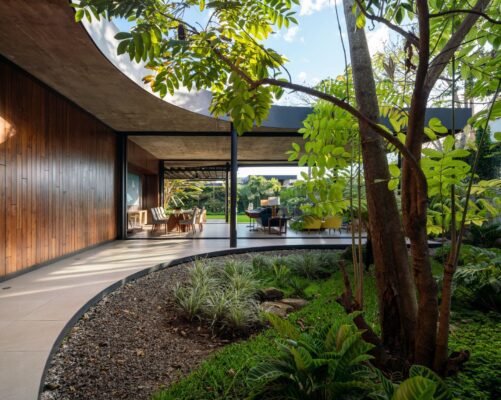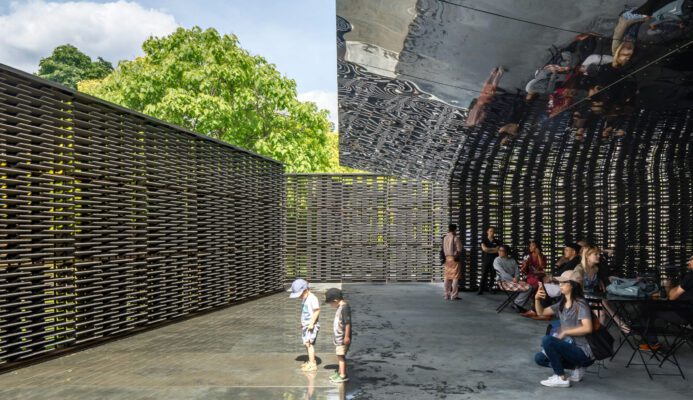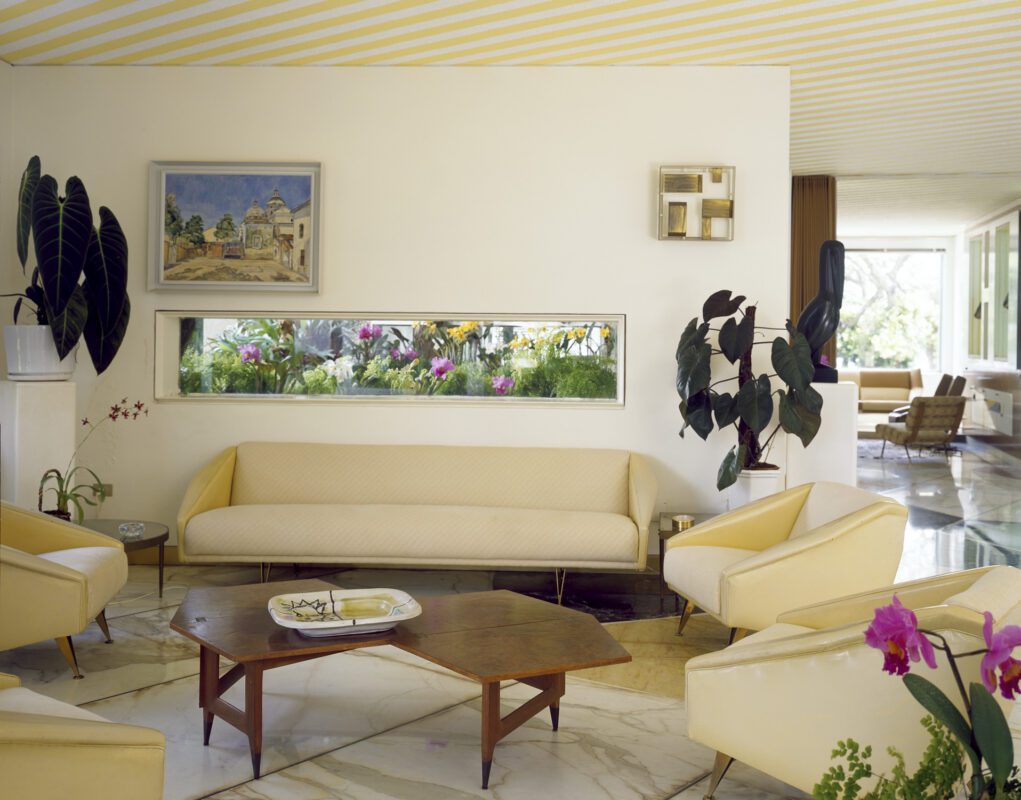
COFFEE WITH
CATERINA LICITRA ON GIO PONTI: “HE LEARNED FROM INCORPORATING THE RICHNESS OF THE TROPICS”
Name: Caterina Licitra
Profession: Designer and catalyst for artists, co-founder of Lisa Ponti Archives
Place of birth: Milan, Italy
Zodiac sign: Leo
Instagram: @catlicitra
LATINNESS: Before delving into the work of your great grandfather, the Italian architect and designer Gio Ponti, in Latin America, we’d love to get to know you more…
CATERINA: I’m a designer, but I became a designer much later. I was really against architecture, artists and anything to do with art when I was younger. I think when you come from a family where everyone is an architect or an artist, you’re like, ‘Oh God, one more’. I went to university in London at Regents’, and studied Media Communications and International Relations. I wanted to become an Italian ambassador, so I did two internships in Mozambique and in Qatar to be an Italian ambassador. Then in Qatar, I realized that was not my goal, and continued with marketing and media communications. Once I graduated, I moved to Thailand, and that’s when I discovered that I actually love furniture.
If you have that one sofa, or chair or lamp that makes you feel at home, you´re home anywhere you are. I wanted to do my collection in Thailand, but it’s not as easy as it sounds because when you’re a foreigner, everything is overly charged. I eventually went to Valencia, which is where I made the collection. I got really inspired by my Asian trip and Gio Ponti. The angel wings are very inspired by him, because he loves angels, so a tribute to him. After I made myself the ambassador of Gio Ponti, educating and getting people to know who Gio Ponti is worldwide.
LATINNESS: During the pandemic, you were the project Manager of Alone Together, an artist residency in Colombia. Just like your great grandfather, you were working with Latin America.
CATERINA: I love Latin America. I love how things happen again. Gio Ponti was born in 1891 and I was born 1991, so 100 years. It is such a big number, as well, so it’s very nice how different things happen at the right time. Gio Ponti taught every one of us how to work with artisans, that is the core, you learn from the artisan itself, and that’s why I love the project in Colombia that we’re doing, because we’re maintaining this beautiful tradition of Colombia, and this terra roja.
It’s so interesting how you can learn so much, but the beauty about it is how to incorporate it. This was something Gio Ponti always had, and he was so modern in this. It was taking the artisanry and reusing them in a modern way, and this is what we are doing in Alone Together, as well. I really believe the future is handmade, so we need to help the artisans and the craftsmanship to survive with technology nowadays. Not change it, but to really understand how they work and create beautiful things. This was something Gio Ponti always did, and now I have the option to do it through Alone Together.
LATINNESS: What’s your first memory of Gio Ponti? When did you realize how far reaching his legacy was?
CATERINA: So interesting that you say the word legacy. There was an article in Cereal Magazine on legacies, and they chose me linking it to Parco dei Principi in Sorrento. We did the special edition just for Parco dei Principi. How I met Gio Ponti (even though I obviously never met him) is through my grandmother, Lisa Ponti, his favorite daughter. They worked their entire lives together.
Gio Ponti and his daughter, my grandma, worked on Domus, the magazine, and Stile, which were the first magazines of art and architecture worldwide. I met Gio Ponti through my grandma, through her funny anecdotes, and obviously, the furniture at home, because everywhere we had pieces of Gio Ponti´s furniture.
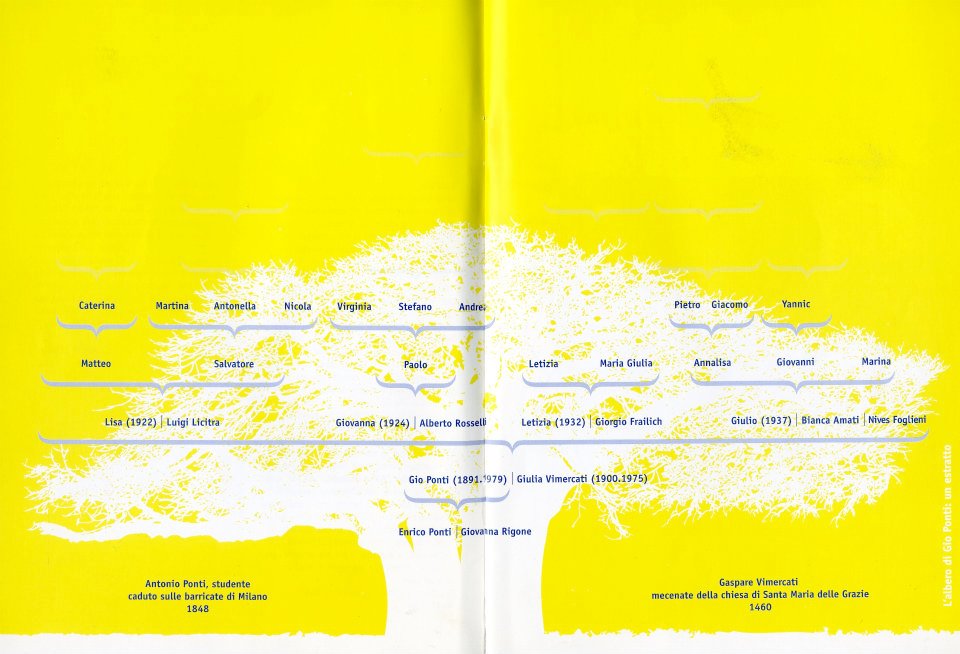
LATINNESS: How amazing to grow up unconsciously surrounded by this legacy.
CATERINA: So via Randaccio, which was the first villa he made in Milan, is where my grandma lived. Unfortunately she passed away last year, and Melotti, who is one of the main artists for ceramics (they worked together for a long time), still lives there with his family.
The beauty about via Randaccio is that it was a network, a meeting point for artists and artisans. Since I was young, I’ve always met them, but you know, when you’re young and you see them all the time, it’s like family members. Later on I realized I met Ettore Sottsass, and I was chilling with him, half in pajamas because he was at home. It’s when I grew up, I realized who I knew without knowing who they were.
It’s cool, because it’s so informal. There’s this beautiful blue table that my grandma had in her house, which is where everything happened. There and in her kitchen, which was designed by Gio Ponti, the kitchen table. Everything happened in these two places, the living room and the kitchen. No cooking, just working. That’s how I met most of the artists and architects. I guess being raised between art and architecture, there’s no boundaries.
LATINNESS: What first brought Gio Ponti to Latin America?
CATERINA: He traveled a lot for those times, despite it being complicated to travel. He was a Scorpio, so always very strong and adventurous. Every adventure was a new way of reevaluating himself and showing his talents. He was very drawn to the great journeys that he had in Latin America. Gio not only went to Venezuela, but to Mexico and Brazil, as well. In Brazil he did a project, but unfortunately, it was never executed, so only in Venezuela, where he actually exploded. He had lots of fans and all his clients became friends.
For him, the most important thing was that the architect becomes the father, and the woman of the house becomes the mother, and the son or daughter is the villa that comes. He always asks the ladies of the future home, what are their dreams? Then he would incorporate their needs because he created villas to be lived in. He always said, joie de vivre, in French, because the house has to be lived in. This is why Villa Planchart, for example, has so many details. In every picture you see different motifs that you won’t see at first. At first you see something, then you look at it again, and you see something beautiful.


LATINNESS: Can you give us some examples of these details?
CATERINA: There are some beautiful panels on the top of the living room, and the beauty about it is if you look at it, it just looks like a painted window or a painted wall, but they were used to make air space, and at the same time, for the family members during receptions to spy on the guests. This is very Italian and Latin American, you know, for gossip. You can’t really tell from downstairs, so it was like a secretive way, and it was made on purpose for this reason.
The beauty about Villa Planchart, for example, is that he learned something new. For example, when Anala, the owner of the house telegraphed Gio Ponti, she said “I want my orchids to have a beautiful space.” He had no clue what orchids were! So then she had to describe them and make him understand what orchids are and how they need special light. You didn’t have this in Milan, I mean now yes, but not during that time.
It was so interesting for him to hear this, understand and to be open minded without seeing the location yet, and to try to incorporate it. He really got a lot of richness from Latin America, from the tropics, from the plants and the flowers and the colors. He always loved color. You can see in all his villas in Caracas, or even worldwide, he always uses the dual color, biochrome. So most tiles in the villas are always white and another color. Villa Planchart is mainly white and sand colors, yellow as well. There’s lots of brown for the armoires and the furniture. Blue, as well.


LATINNESS: Apart from the colors, we notice Gio Ponti loves open spaces?
CATERINA: He loves to have open spaces. Villa Planchart has a huge hole in the middle of the house to incorporate natural light. He loves to work with what is already happening around with the context. He doesn’t like to destroy the scenery. He likes to work with the scenery of the place so that it looks like you’re outside, but inside. There’s no more boundaries between the outside and inside. So if it starts raining, it rains inside. You can see the moon, and it not only gives the interior a breather, because obviously the air comes in, but also, if you’re home for a while, you don’t feel suffocated by it. We would understand it more now in the quarantine days.


LATINNESS: He was not only an architect, but an interior designer for his homes. Can you tell us more about the interiors of Villa Planchart?
CATERINA: This here is one of the wardrobes, as you can see, it is like a game of geometries and shapes, but then these are all hidden armoires. As soon as you enter, you have the visual aspect, but you don’t think that there’s the functionality as well.
Then the beautiful stairs, he loves to be known for his stairs. Anala and Armando talked to Gio Ponti about the beauty, about crystals and the energies that come through them, so he wanted to give it a next step, and that’s why every stair has beautiful Carrara marble that he shipped from Carrara to enhance the power of the crystals and the energies. Once you step up, you illuminate to a different stage.
The beauty about Villa Planchart, for being in the 50s, is not only the interiors, but also the roof, which looks like a sheet of paper put on top, and he used the light to define it, so it looks like it’s flying away.


LATINNESS: Precisely one common theme we see about Gio Ponti’s design is a sense of lightness. Can you tell us more?
CATERINA: So his main points for architecture, furniture design and anything he created, even textiles, is lightness. Everything has to be light. For example, when he made the superleggera chair, he eliminated all the unnecessary heaviness, so it’s not like a block of heavy cement, although he used cement, but in a light way. He managed to use just the essential parts of it.
He also loved the fact that you can see through, so even from the outside here, you can see inside the roof. He loved to play how the roof and the floor are working together. It’s like a patchwork of colors and shapes. Everywhere you turn, your eyes have a beautiful sight, and you can never get tired of the view, even if you live there, you will spot something different depending on the time of day.
There’s this beautiful sentence that came when he did Villa Planchart, the people from Caracas named it a Florentine Villa. For him it was very interesting, Florentine Villa, he was very happy about it, and I’m going to read you this that my grandma wrote: “A Florentine Villa in Caracas, this pleased Ponti whose Italianness was something that he was never worried to not be Italian enough, but he loved that this was really seen.”
He really loved Latin America. For him it was a pretty open minded experience from the richness that Latin America can give, with all of the beautiful materials and the plants, the food as well. There’s a really funny anecdote that I actually just discovered. When Gio Ponti was building Villa Planchart, there was another villa where the Planchart´s hosted him and lived in themselves while they were constructing. Venezuela was under a dictatorship, and the house where they were staying was right next to his private airport. So, in the middle of the night at 3:00 AM, Gio Ponti heard this really loud sound, and was like, ‘What is this?’ Until he realized that it was the private plane of the dictator leaving Caracas. He goes to the Plancharts to wake them up, saying ‘You guys are free! There’s no more dictator!
Anala always tells the story of how Gio Ponti was the first person who saw liberation. He was really a part of it, and he loved staying in Caracas. That’s why he did so many projects, although some did not happen. For example, the Guzman villa, he designed it. We have all the prototypes, but as we know, it was never executed. However, it turns out now it was executed because the owners just wrote to me on Instagram saying, ‘Oh, I’m staying in the house of your great grandfather.’ I just don’t know who did it. These are the things about Latin America where you probably don’t know everything, so you find out.
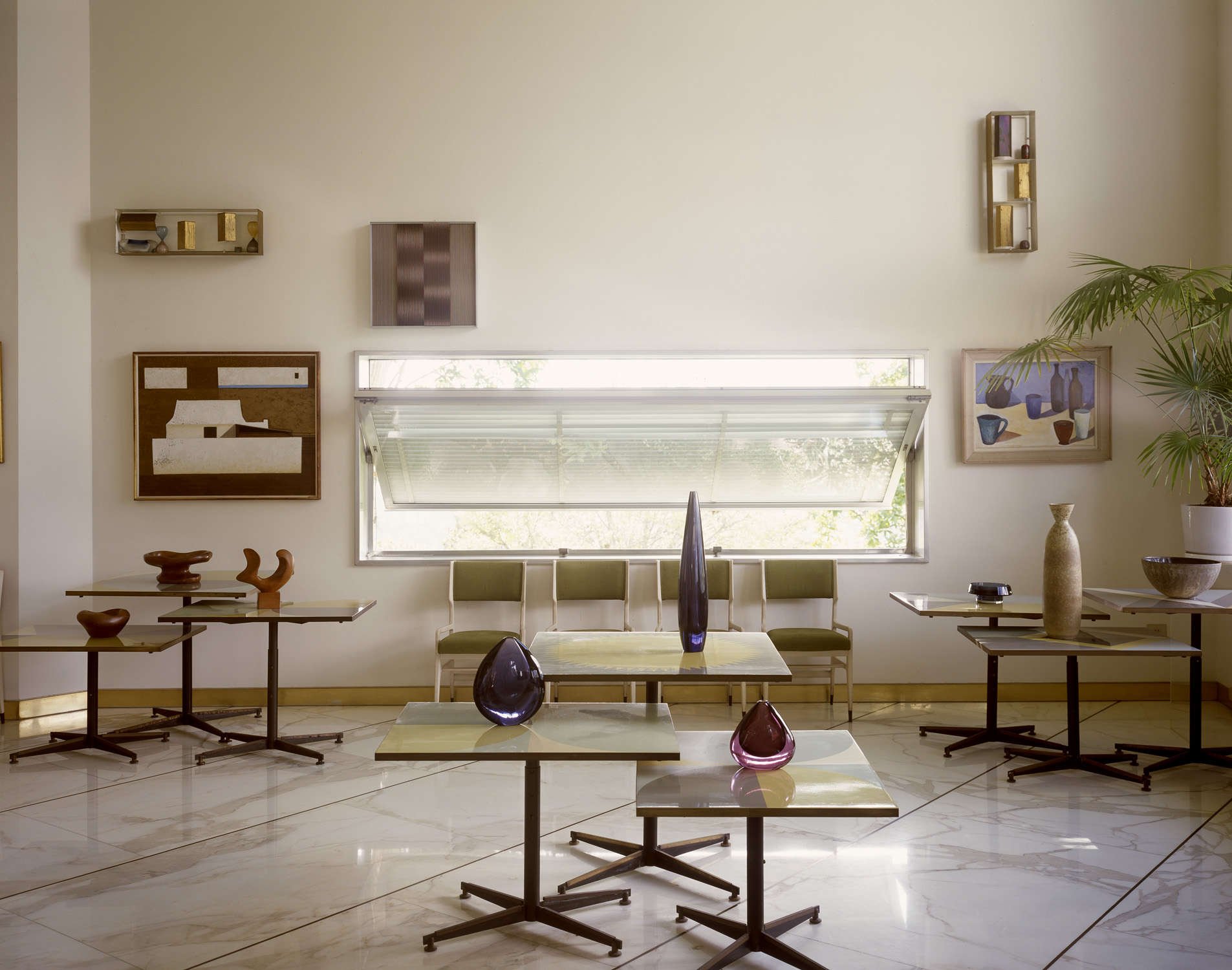
LATINNESS: Venezuela was very avant-garde and sophisticated at the time because not only did they have Gio Ponti´s work, but also homes designed by the Italian architect Gae Aulenti.
CATERINA: Yes, and they (the Venezuelans) wanted to always have the best. They always wanted to give that little glimpse of beauty, you know? I think that at that time, even though some people were very corrupt, they always wanted to show the beauty of the country. I can speak for Gio Ponti, he tried to incorporate their ancestral knowledge with the lightness and modernity of Italian design.


LATINNESS: Despite having built dozens of other buildings in Europe, Villa Planchart is still considered one of his masterpieces. Why?
CATERINA: Even for him it was one of his masterpieces. He loved Villa Planchart, and he always went back. I think it’s because he really had carte blanche to really explore and do whatever he felt. He worked with Anala and Armando, and then he really did an explosion of colors and emotions. As my grandmother says here: “Gio Ponti really had the occasion to experiment from the objects that he made only for Villa Planchart.”
There was a challenge of being on top of a mountain and the mountain views, a different language. It was really a way of showing that avant-gardeness of who he was and who his clients were. The funny story is Melotti, the one who does all the ceramics, hated to travel. Whenever Gio Ponti went to visit him in Milano, my grandma told me that he used to hide and say: ‘Where does he want to make me go?’ He was not like Gio Ponti, who was really adventurous and wanted to explore and learn more.
When he came back from Latin America, he did the Alitalia building in New York, so he brought some of the colors of Latin America to New York through his experiences. For him everything was a developing, never ending journey.


LATINNESS: Who is living in the Villa Planchart now?
CATERINA: It’s a foundation now, but the actual nieces live there. I met Carolina Figueredo during an exhibition we did at the Musée des Arts Décoratifs in Paris in 2019 (which was very successful with more than one hour queues). It was so interesting, so beautiful because I discovered that from two sons, one of them has a band, and he took a cool video in Villa Planchart. They still give access to people, so you can go visit and can take photos. There’s lots of music happening, so they like to live it because this is exactly how Gio Ponti envisioned it for Anala and Armando, it´s la villa per vivere.
LATINNESS: With all these journeys, Gio Ponti must have been a great networker.
CATERINA: Yes, the beauty about Gio Ponti was the way of connecting and keeping track with everyone through letters and drawings. He used to draw these beautiful, hand-painted letters that he would send to friends, family members, companies which he worked with, and so on. Some of them had a sketch on the back. Even his own people in his studio, they would get these beautiful letters which actually said like: ‘We’re changing the whole project, by the way.’
He always had these new encounters, and through them, he luckily had new clients. This is how it happened with Villa Planchart, Villa Arreaza and the interiors of Beracasa, as well as another two projects he had. He created a community, and they became unknown collectors through his letters because one of these is like having a piece of art now.


LATINNESS: I love what you said about community, and the way in which he invited his friends and network to help build these masterpieces.
CATERINA: Yes. For him, that was very important. In Villa Planchart, every object you see inside was made just for Villa Planchart. For example, he made some beautiful vases just for Villa Planchart, for the special orchids and the color tables. In Venezuela, he loved the sun and the moon, so they are the major symbols, and he puts some very funny fishes, as well, on the roof of Villa Planchart. He likes to be very playful, and he uses the same motif of the star, moon and sun for Villa Arreaza´s lounge seats.
LATINNESS: And he had two Villas in Caracas that he actually built?
CATERINA: Yes. Villa Planchart which is still there, luckily, and Villa Diamantina, which was a gorgeous one. Unfortunately, it was destroyed by a wild heir. When the owner disappeared, the new heir didn’t like it, so destroyed it.
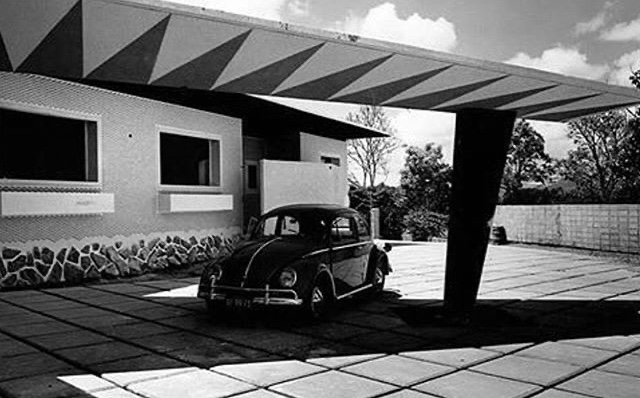
LATINNESS: What’s the story behind Blanca Arreaza?
CATERINA: Blanca was the owner of Villa Arreaza (also referred to as Villa Diamantina). She disappeared. I’m not sure what happened, but from what my grandmother said, this villa was created for parties because they were a family which loved to have people over for cocktails. This villa was in El Cedrito area, but inside the country club, so instead of being on top like Villa Planchart, it’s on the bottom.
Gio Ponti decided to make the roof go up so that the view would not be blocked by the mountain, but you could have the scenery of the light next to the mountain. It has a big roof, which covers seven small patios. There’s lots of outdoor, indoor spaces as well, because this was very good for cocktails. Then there’s this beautiful pool, which for Gio Ponti, pools are very important. A pool can never be a real pool, he hates rectangular pools. That does not exist for him because why does it have to be rectangular, it can be any shape. The pool for Villa Arreaza, or as he used to call it hermosisima diamantina because it had a diamond shape.
Green and blue are the main colors of Villa Diamantina, and of course, white to balance it out. He did the whole interiors for this one, as well, personalized, but the beauty of Villa Diamantina for me is in the surface. The surface, which could even be called the skin of the building, or small tiles, are all diamond shaped. The beauty of Gio Ponti´s villas in Latin America, and elsewhere, is that you can use all five senses- the sight and lots of tactile. Whatever surface you touch, you really feel it. It gives you an emotion, and this type of tile, the diamantina, is beautiful because when the sun hits, it creates a shadow, so he plays with shadows, too. It gives a different light for a different type of the day. Obviously in Latin America, you guys have lots of sun, so with this type of tile, it cools it down a bit more because it diverts the sun in a different area giving you a shade. He used the same tile, diamantina, in the Denver Museum, but that idea came from Caracas.


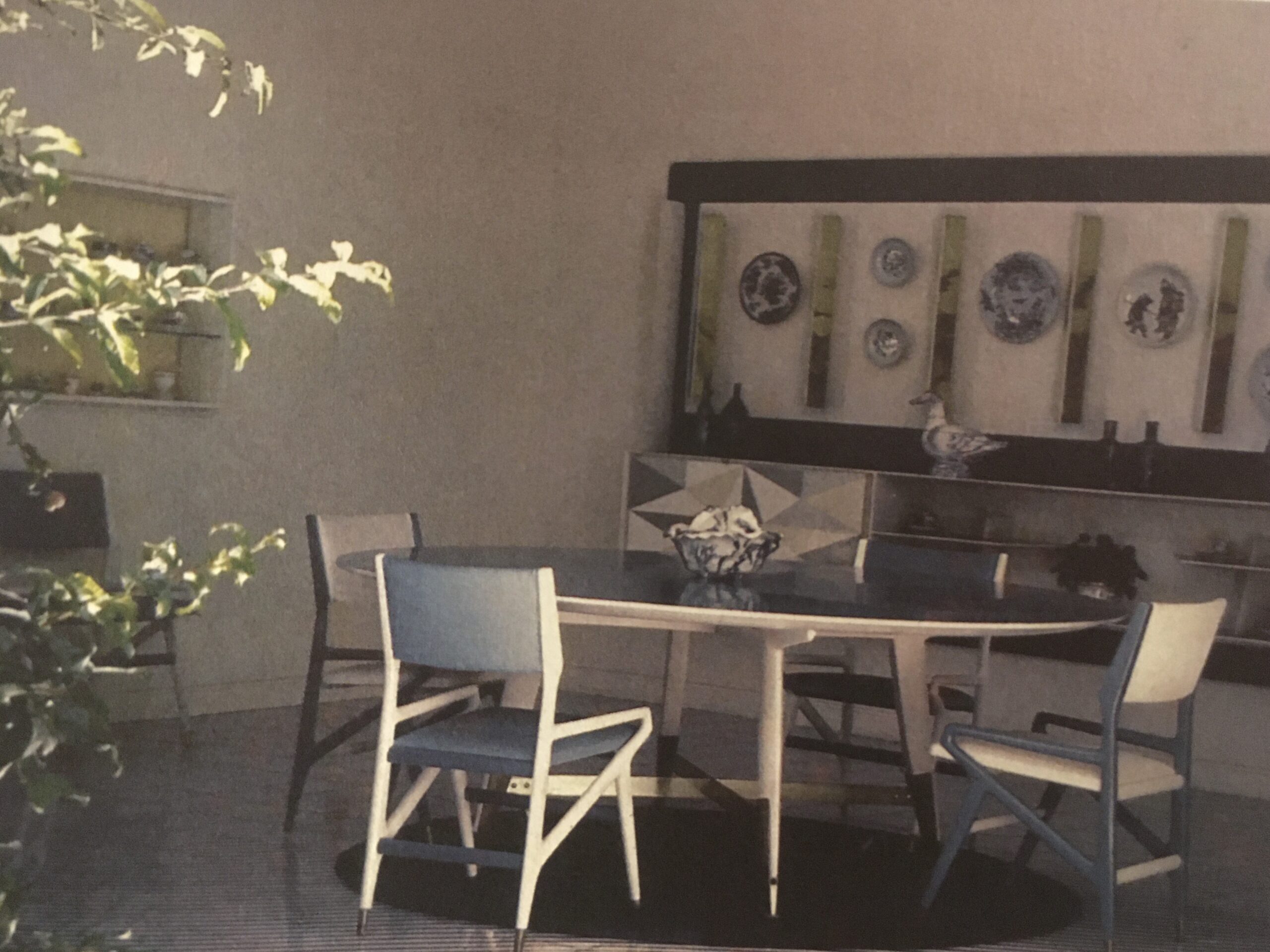
LATINNESS: What do you think he loved most about Latin America?
CATERINA: Well, he never wanted to come back. He would stay for a long time, even overstayed at times. That’s why he was very excited about having different friends and clients, but he always instated friendships. The most beautiful thing, which I’m doing myself too, I learned from him, is to have human contact. They’re your client, of course, but at the same time, they’re human.
I think this got very passionate and more intertwined when he was in Latin America, because I guess they had different values of friendships, as well, in comparison to Italy at that time. My grandmother used to portray him as a happy medium, he was always happy and always connecting. I became an art catalyst following the steps of Gio Ponti.
I don´t know if you know about L’Ange Volant, outside of Paris? It’s a beautiful villa, as well, which he made through an encounter. He was there on a trip with his niece, Carla Borletti, (my great grandmother, Giulia Vimercati, was from a noble family of Milano) so he was there with Carla, bringing her to Paris, and met his client there, who was Christofle, as in the silverware. Then the niece fell in love with this person who was the owner of Christofle, the whole love happened, and the new baby was this beautiful house in the countryside made by Gio Ponti.
He learned so much from the nature you guys have, trying to incorporate the richness of the tropics. My grandma says this beautiful word for Villa Planchart: “Villa in Caracas, 1955 has a unique combination of inventions and designs and delights, as rich as the tropical vegetation it incorporates new research emerging off Ponti´s journeys in Latin America.” So everything started there. Latin America was very rich in materials, it really exploded his senses.
LATINNESS: What a beautiful legacy to have in your family.
CATERINA: I was very lucky because my best friend was my grandma. I was 24/7 with her, either in person or on the phone, and I learned so much. This is why I’ve met Gio Ponti, in a funny and beautiful way, not in a scholastic way. I never studied architecture or art, I just discovered that I know how to do things. Probably going back to DNA, but at the same time, it’s nice to find your own way to go back to your family roots.
Images courtesy of @catlicitra

